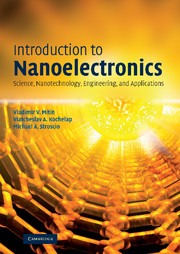Book contents
- Frontmatter
- Contents
- Preface
- List of notation
- 1 Toward the nanoscale
- 2 Particles and waves
- 3 Wave mechanics
- 4 Materials for nanoelectronics
- 5 Growth, fabrication, and measurement techniques for nanostructures
- 6 Electron transport in semiconductors and nanostructures
- 7 Electrons in traditional low-dimensional structures
- 8 Nanostructure devices
- Appendix: tables of units
- Index
5 - Growth, fabrication, and measurement techniques for nanostructures
Published online by Cambridge University Press: 05 June 2012
- Frontmatter
- Contents
- Preface
- List of notation
- 1 Toward the nanoscale
- 2 Particles and waves
- 3 Wave mechanics
- 4 Materials for nanoelectronics
- 5 Growth, fabrication, and measurement techniques for nanostructures
- 6 Electron transport in semiconductors and nanostructures
- 7 Electrons in traditional low-dimensional structures
- 8 Nanostructure devices
- Appendix: tables of units
- Index
Summary
Introduction
Having reviewed the basic properties of materials exploited in nanoelectronics, we shall now study the principal methods of high-quality material growth and nanodevice fabrication. Methods for the growth of perfect materials with controllable properties are critically important for nanostructure fabrication. Indeed, stringent requirements must be met for the growth of crystals for nanosize devices. These requirements include many factors and, first of all, ultra-high quality and purity, both controlled within extremely close limits. The following examples illustrate the term “ultra-high quality.” For Si crystals used in nanodevices, concentrations of controlled impurities currently reach concentrations of less than one part in ten billion (1 in 1010). For the case of Ge, this number is in the range of 1 in 1013−1014. The quality of a silicon crystal being used for nanoelectronics can be characterized in terms of the density of defects: they must be limited to several tens per 1 m2 (!) of the Si wafer according to the Semiconductor Road Map, that was discussed in Chapter 1. The basic methods of growth of perfect crystalline materials and multilayered heterostructures we will discuss in Section 5.2.
To fabricate a nanostructure and a nanodevice two approaches can be undertaken. The first is based on a previously grown perfect material with further processing. This includes a number of fabrication stages and methods (nanolithography, etching, implantation, selective doping, etc.). In Section 5.3 we review these methods.
- Type
- Chapter
- Information
- Introduction to NanoelectronicsScience, Nanotechnology, Engineering, and Applications, pp. 109 - 164Publisher: Cambridge University PressPrint publication year: 2007



